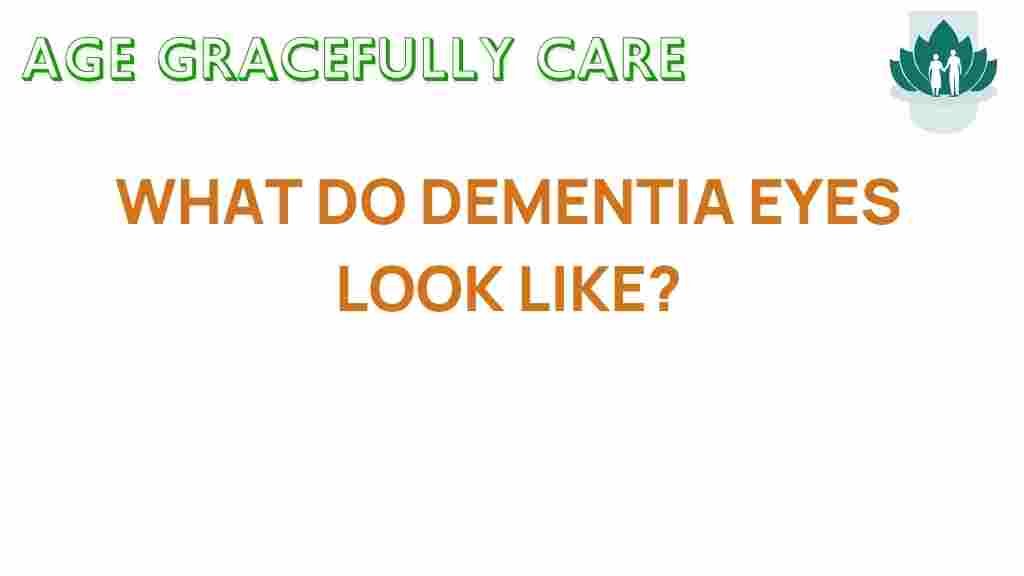Unveiling the Mysteries: What Do Dementia Eyes Reveal?
Dementia is a complex condition that affects millions of people worldwide. As cognitive decline progresses, various symptoms emerge, and the eyes can often serve as a window into the health of an individual with dementia. This article explores the connection between dementia and eyes, examining how changes in vision and eye behavior can signal underlying issues related to dementia. We will also discuss the importance of awareness regarding these symptoms, the diagnosis process, and the care needed for individuals experiencing dementia.
Understanding Dementia and Its Symptoms
Dementia is not a single disease but encompasses a range of symptoms associated with a decline in cognitive function. This condition primarily affects memory, thinking, and social abilities, severely impacting daily life. The symptoms often vary based on the type of dementia, but common signs include:
- Memory loss
- Difficulty in planning or solving problems
- Challenges in completing familiar tasks
- Confusion regarding time or place
- Changes in mood and behavior
As dementia progresses, other symptoms may emerge, often including changes in vision and eye behavior. Understanding these changes is essential for caregivers, family members, and healthcare providers.
The Connection Between Eyes and Dementia
The eyes can provide crucial insights into the health of an individual with dementia. Various studies have shown that changes in eye movement, visual processing, and even the appearance of the eyes can indicate cognitive decline. Here’s what to look for:
- Altered Eye Movement: Individuals with dementia may exhibit slowed or erratic eye movements. This can affect their ability to track objects or maintain eye contact.
- Pupil Reaction: Changes in pupil size and reaction to light may occur in those with dementia, hinting at neurological changes.
- Visual Perception Issues: Many individuals with dementia struggle with depth perception and spatial awareness, which can lead to accidents and confusion.
- Dry or Red Eyes: Caregivers may notice changes in the eyes’ appearance, such as dryness or redness, which can be linked to decreased self-care.
Step-by-Step Process: Identifying Eye Symptoms in Dementia
Recognizing the signs of cognitive decline through eye symptoms requires a methodical approach. Here are the steps to take:
- Observe Behavior: Watch for changes in eye contact, the ability to follow moving objects, and how the individual interacts with their environment.
- Monitor Pupil Response: Take note of how the pupils respond to changes in light. Delayed or inconsistent reactions may indicate neurological issues.
- Assess Visual Skills: Conduct simple tests to check for depth perception and spatial awareness. For example, ask the individual to reach for a familiar object.
- Consult Healthcare Professionals: If you notice significant changes, it’s essential to consult with a medical professional for a comprehensive assessment.
Diagnosis of Dementia Related Eye Symptoms
Diagnosing dementia requires a multifaceted approach. The healthcare provider will consider a range of factors, including:
- Patient History: Gathering detailed information about cognitive and physical changes over time.
- Cognitive Testing: Standardized tests to evaluate memory, problem-solving skills, and overall cognitive function.
- Physical Examination: An eye examination may be conducted to assess any physical changes to the eyes.
- Neurological Assessments: Imaging tests such as MRIs or CT scans may be utilized to observe brain changes.
It’s crucial to remember that early diagnosis can lead to better care strategies and improved quality of life.
Care Strategies for Individuals with Dementia and Eye Symptoms
Providing care for someone with dementia involves understanding their unique needs, particularly regarding visual health. Here are some effective care strategies:
- Environment Optimization: Ensure good lighting and reduce glare in living spaces to help with visibility.
- Routine Eye Checkups: Regular visits to an eye care professional can help monitor changes.
- Engagement in Activities: Encourage activities that stimulate visual processing, such as puzzles or art projects.
- Safety Precautions: Implement measures to prevent accidents, such as removing obstacles and using contrasting colors for better visibility.
Behavioral Changes and Their Implications
Behavioral changes are common in individuals with dementia, and these can be exacerbated by eye symptoms. Understanding these behaviors is vital for caregivers:
- Increased Frustration: Difficulty seeing can lead to frustration, resulting in increased agitation or withdrawal.
- Altered Communication: Changes in vision can impact how individuals interact, possibly leading to misunderstandings.
- Changes in Mood: Eye-related difficulties may contribute to mood swings or decreased motivation.
Awareness of these behaviors allows for better communication and support strategies, enhancing the care provided to individuals with dementia.
Troubleshooting Tips for Caregivers
Caring for someone with dementia requires patience and understanding. Here are some troubleshooting tips for managing eye symptoms and related behaviors:
- Stay Calm: If the individual becomes frustrated, calmly reassure them. Use a gentle tone and maintain eye contact.
- Use Visual Cues: Incorporate visual aids and cues in the environment to help with orientation and recognition.
- Encourage Routine: Establish a consistent daily routine to provide structure, which can reduce anxiety.
- Seek Support: Don’t hesitate to reach out for professional help or support groups for caregivers.
Conclusion: Raising Awareness for Better Dementia Care
The eyes can reveal much about a person’s health, particularly in those experiencing dementia. Awareness of eye-related symptoms can lead to early intervention, better diagnosis, and more effective care strategies. As we age, understanding the connection between cognitive decline and visual health becomes increasingly important.
By recognizing the signs and being proactive in care, caregivers can significantly enhance the quality of life for those affected by dementia. For more information on dementia care, visit this resource for comprehensive support strategies.
Ultimately, embracing a holistic approach that considers both cognitive and visual health is essential in the journey of living with dementia. Let us continue to raise awareness and provide compassionate care to those in need.
This article is in the category Health and created by AgeGracefullyCare Team
